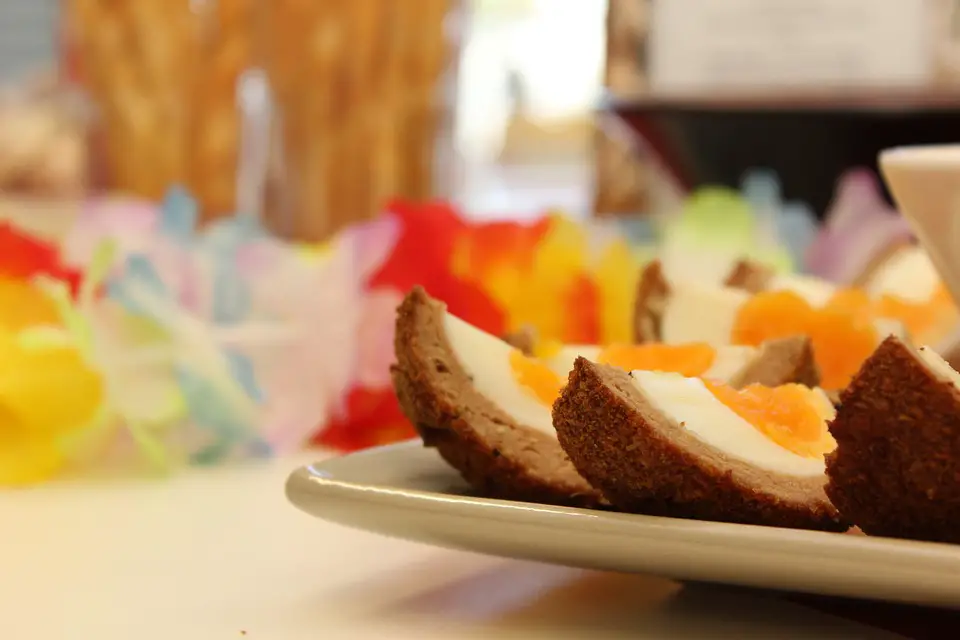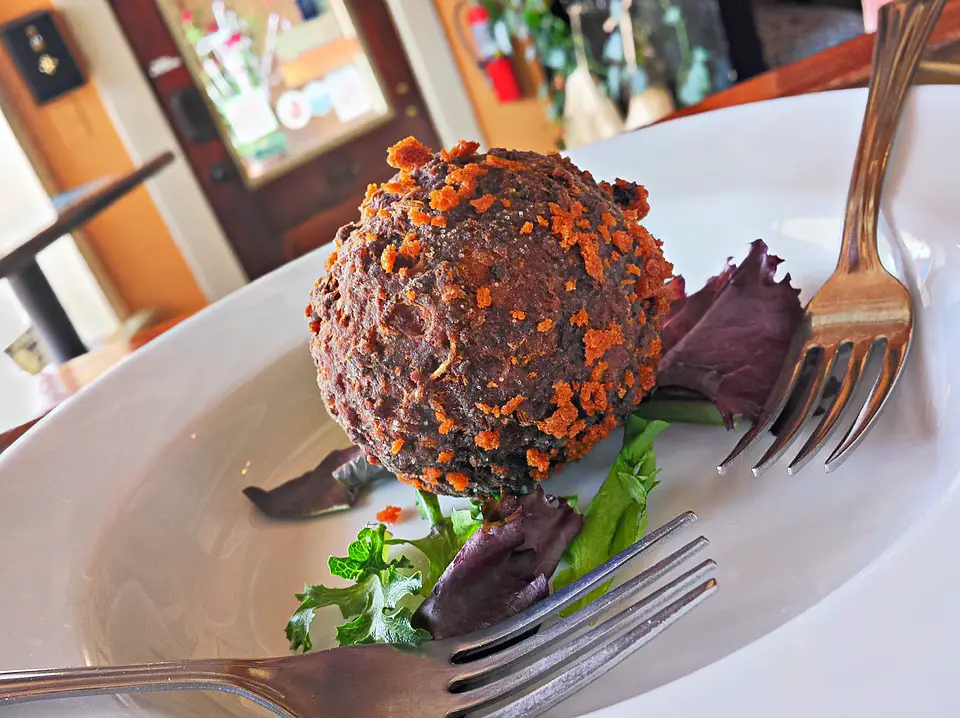Scotch eggs can be eaten cold, but they are considerably tastier when heated.
The challenge is reheating them without overcooking the egg or causing the breading to become soggy and unpleasant.
A scotch egg is best reheated in the oven. Set the oven to 350 °F (180 °C). Place the Scotch eggs on a wire rack or baking sheet. Scotch eggs should be reheated for 10 to 15 minutes. Cut large (and hard-boiled) Scotch eggs in half to enable complete heating.

How to Reheat Scotch Eggs?
1. In the Oven
Set the oven’s temperature to 350°F (180°C). Place the Scotch eggs on a wire rack or baking sheet. Based on their size, heat the Scotch eggs for 10 to 15 minutes. Consider cutting large (and hard-boiled) Scotch eggs in half to facilitate complete heating.
Set the oven to 350 °F (180 °C).
Put the Scotch eggs on a wire rack or baking sheet and bake them.
Optional: Larger, hard-boiled eggs should be cut in half to ensure complete heating. Put them on a baking sheet cut side down.
Depending on size, heat the Scotch eggs for 10 to 15 minutes.
It will take a little trial and error to find the ideal timing because your eggs’ sizes will vary.
Stick a sharp knife into a Scotch egg and feel how hot the metal is when you pull it out to see if the Scotch eggs are hot inside.
The Scotch eggs are done if the metal is heated.
2. In the Microwave
Scotch eggs can be reheated in the microwave by cutting them in half or quarters and setting them on a dish lined with paper towels. The Scotch egg should be heated for 15 seconds. Once you’re sure it’s heated all the way through, heat it for another 10 seconds at a time until the temperature you want is reached.
To stop your Scotch eggs from blowing up, cut them in half or into quarters (yes, this is a real risk).
Slice the Scotch egg and place it on a platter that can go in the microwave. Microwave for 15 seconds.
Check to see if the eggs are fully warmed.
Continue heating in 10-second intervals if necessary.
The eggs should sit for 30 seconds after they are fully heated before being served.
Whole-cooked eggs shouldn’t often be reheated in the microwave.
What are the Signs that Indicate an Edible Egg?
A good source of protein and other nutrients is eggs. Despite having a long shelf life, eggs can degrade even when stored properly. There are, however, a few quick techniques to tell if an egg is still edible.
In this article, we’ll examine a few quick ways to tell if an egg is safe to eat. We also discuss how long eggs stay fresh, if they need to be refrigerated, and the risks associated with consuming damaged eggs.
1. Try Out your Nose for Size
You can smell an egg to find out if something is wrong with it.
One of the simplest and most reliable methods to tell if an egg has gone bad is to smell it.
A rotten egg releases a foul odor when the shell is cracked open. This smell will persist even if the egg has previously been fried. Before cracking an egg open, a person may occasionally detect the foul stench of an old or decaying egg.
Any eggs that smell bad or unpleasant should be thrown away. It’s a good idea to give each egg a good sniff before using this test because it’s so accurate.
2. Visual Assessment
An egg can occasionally seem or feel weird. The food should be inspected for signs of rottenness or contamination.
Cracked or slimy eggs may have been contaminated by bacteria, or mold growth on a shell covered in powder may have occurred.
A second visual inspection should be done after the egg has been cracked open if the shell is intact, devoid of damage or contamination, and does not smell. Any eggs with an unusual color, such as pink, iridescent, or greenish yolks or whites, should be discarded.
The United States Department of Agriculture states that fried eggs with a green ring on the hard-cooked yolk are safe to consume (USDA). Common causes of the green color include overcooking or high iron content in the cooking water.
Is it True that Eggs are Good for People with Diabetes?
Eggs are a low-glycemic, high-protein food with a low carbohydrate content. As a result, they are an excellent protein source for diabetics.
Eggs are good for diabetes, according to the American Diabetes Association (ADA). A food’s blood sugar levels are negatively impacted if it has a low glycemic index.
Some people might be concerned about the cholesterol content of eggs. However, researchers believe that consuming eggs in moderation has no negative effects on cholesterol levels.
How Long will Eggs Remain Fresh?
The FDA advises using eggs within three weeks of purchase to ensure the best quality. However, Donovan has a slightly longer shelf life—six weeks in the fridge for farm-fresh eggs and four weeks for eggs purchased at the supermarket. Store-bought eggs will be older due to shipment, she observes, explaining the shorter shelf life.
Donovan claims that if you use eggs from your chickens, they can last for up to two weeks if they aren’t refrigerated and are just placed unwashed on your kitchen counter. For the duration of their shelf life, eggs must be kept at lower temperatures after being rinsed (which is only necessary if the eggs are covered with dirt or chicken poop).
This is supported by some agricultural science: “Eggs have a protective layer called the bloom on them when they are placed,” says Donovan. Bacteria cannot enter eggs because they are porous, according to the researcher. However, when the bloom has been removed, eggs must be chilled to ensure their safety.
How to Peel the Cooked Eggs?
On a hard surface, lightly roll and tap each one to crack the shell completely. Take each one’s outer shell and membrane off. I find it simpler to start removing the shell of each component from the top. Work gently because, if you’re not careful, if the eggs are soft-boiled, some of the white may fall off with the peel. It is easier when they are hard-boiled.
To simplify, consider peeling your hard-boiled eggs under cool running water. For the egg to become simpler to shell, run the cold water over it for roughly 15 seconds. Start peeling your egg from the bottom after cracking the shell by tapping the bottom against a countertop or sink.
Your eggs should be started in already boiling water or steamed, cooled in ice, and gently rolled to generate many fractures in the shell before peeling. Another option is to try shaking them in a glass if you’re feeling very brave.
How to Boil Eggs for Making Scotch Egg?
A soft-boiled egg should take two minutes, 20 to 30 seconds, or a little longer if they are larger than usual. After three minutes of medium-high heat, the whites will be just set and the yolk will still be liquid. The egg whites will be set, and the yolks will be firmer but still brilliant and moist. Four minutes were spent boiling them. For a somewhat set yolk and a set white, which takes around 4 minutes, the whites and yolks will be fully set. Cook for 5 minutes to achieve a firmer, medium-cooked yolk and white. It takes 6 minutes to cook eggs with a slightly soft yolk.
Bring the saucepan to a boil by turning the heat up to high. When the water comes to a rolling boil, remove the saucepan from the heat and cover it with the lid. 8 minutes will yield a hard-boiled egg. Let the eggs soak in hot water for the following amount of time, depending on the desired level of doneness: Three minutes is needed for a soft boil, six minutes is needed for a medium boil, and twelve minutes is needed for a hard boil.
Are Eggs Considered Vegetarian?
Even if eggs do not come from dead animals, there is discussion as to whether vegetarians should steer clear of goods that do even if they do not consume animal flesh. For instance, fish’s stomachs are sliced open to remove the caviar eggs that are inside. Even though eggs themselves are vegetarian, an animal must be killed to produce them.
Do hens need to perish to produce eggs? Actually, no, not at all. However, in practice, they do. You support factory farming, which kills millions of chickens a year just to acquire their eggs unless you get your eggs from your next-door neighbor and have seen how their farm is run.
Reference: Food intake patterns of self-identified vegetarians among the US population, 2007-2010
The extent to which vegetarians avoid all or some animal products (such as meat, poultry, fish/seafood, eggs, and dairy) varies. We compared the calorie intake overall, the number of food items consumed, and the consumption of specific USDA Food Patterns food categories, subgroups, and food components by self-identified vegetarians and non-vegetarians in the U.S. population aged 1 year and older. SAS 9.3 was used to evaluate weighted reliable food consumption data from the USDA Food Patterns Equivalents Database, 2007–2010, and the National Health and Nutrition Examination Survey, day 1 data, in the US population (n=15,453). 2.1% (or 3%; n=323) of the self-described vegetarians did not eat any animal products.
Conclusion
Scotch eggs can be reheated in the microwave, but the result will be a rubbery egg that doesn’t have the crunch that you would expect. The meat inside is still moist, but it lacks the crispiness you would expect. Another option is to use an air fryer. The frying process should take only a couple of minutes, and the eggs should be covered with oil.
One of the most important things you should know about scotch eggs is their cooking process. You should be sure to follow the manufacturer’s instructions before attempting to reheat them. Otherwise, the egg will not cook properly and will fall apart.

